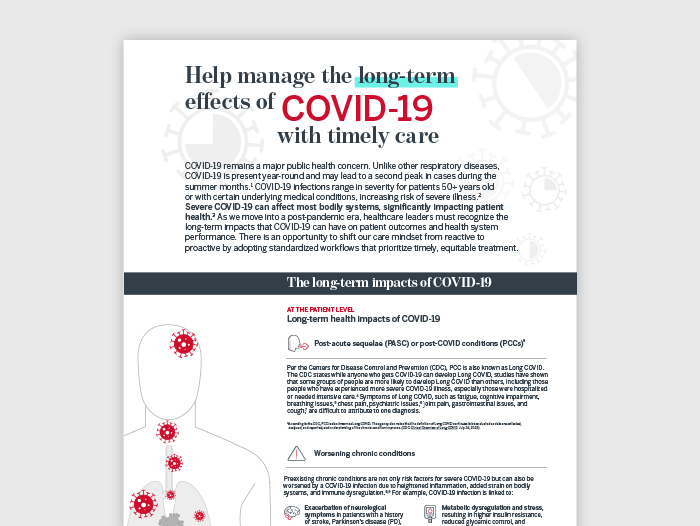Auto logout in seconds.
Continue LogoutAccording to CDC data, both COVID-19 and flu cases and hospitalizations are currently on the rise, leading to concerns that hospitals may soon be overwhelmed by patients sick with the viruses.
COVID-19 hospitalizations are rising
For the week ending Dec. 9, there were 23,432 new COVID-19 hospitalizations, a 3.1% increase from the week before. According to CDC data, COVID-19 hospitalizations have been increasing every week over the last month, with 16,654 new hospitalizations during the week ending Nov. 11.
Overall, five states reported a substantial increase in COVID-19 hospitalizations, and eight states reported a moderate increase for the week ending Dec. 9. The remaining states had stable COVID-19 hospitalization rates or reported decreases.
Flu cases, hospitalizations are also growing
For the week ending Dec. 9, five U.S. states reported very high influenza-like illness (ILI) activity, and 12 states reported high ILI activity. An additional nine states reported moderate ILI activity.
According to CDC, there were 7,090 patients hospitalized with confirmed flu cases for the week ending Dec. 9, an increase from 5,753 patients who were hospitalized the week before.
The percentage of outpatient provider ILI visits during this time was 4.4%, a slight increase from 4% the week prior and above the national baseline of 2.9%. Outpatient provider ILI visits have been above the national baseline for six consecutive weeks now.
So far, CDC estimates that there have been at least 3.7 million flu cases, 38,000 hospitalizations, and 2,300 deaths this flu season. There were also two pediatric flu deaths during the week ending Dec. 9, bringing the season's current total to 14.
Will these viruses overwhelm hospitals this winter?
According to CDC, the recent increases in COVID-19 and flu hospitalizations, as well as other viral illnesses, could strain hospitals across the United States by the end of the month.
"COVID-19 hospitalizations are rising quickly," the agency said. "Since the summer, public health officials have been tracking a rise in multisystem inflammatory syndrome in children (MIS-C), which is caused by COVID-19. Influenza activity is growing in most parts of the country. RSV activity remains high in many areas."
Pediatric hospitals in particular have been dealing with a significant increase in patients, with CDC saying that beds "are already nearly as full as they were this time last year" in some parts of the United States. Data also shows that ED visits from school-age children has almost doubled over the last week, largely due to a rise in flu cases.
A new COVID-19 variant called JN.1, which is closely related to the BA.2.86 variant, may be driving an increase in COVID-19 cases. JN.1 is currently the fastest growing COVID-19 variant in the United States and may make up as much as 29% of all COVID-19 cases nationwide.
"Right now, we do not know to what extent JN.1 may be contributing to these increases or possible increases through the rest of December like those seen in previous years," CDC said.
Although CDC has urged people to get vaccinated against several respiratory viruses, including COVID-19, influenza, and respiratory syncytial virus (RSV), vaccination rates are still low overall.
Currently, only around 16% of adults ages 60 and older have received an RSV vaccine, and only a third of nursing home residents have received a new COVID-19 vaccine. Flu vaccinations are also lagging, with data from insurance claims showing 8 million fewer doses compared to last year. CDC data also suggests that flu shots among children are around five percentage points lower than the same time last year.
"We aren't seeing the uptake in vaccines that we would like to see," said CDC Director Mandy Cohen. "We acknowledge that is too low and it is one of the reasons we wanted to have this conversation." (Tin, CBS News, 12/15; Hollowell, Becker's Clinical Leadership, 12/15; CDC COVID Data Tracker, accessed 12/18; CDC Weekly U.S. Influenza Surveillance Report, accessed 12/18)
Given the influx of respiratory diseases in the United States, health experts are advising caution. Here are five ways you can keep safe this holiday season.
Don't miss out on the latest Advisory Board insights
Create your free account to access 1 resource, including the latest research and webinars.
Want access without creating an account?
You have 1 free members-only resource remaining this month.
1 free members-only resources remaining
1 free members-only resources remaining
You've reached your limit of free insights
Become a member to access all of Advisory Board's resources, events, and experts
Never miss out on the latest innovative health care content tailored to you.
Benefits include:
You've reached your limit of free insights
Become a member to access all of Advisory Board's resources, events, and experts
Never miss out on the latest innovative health care content tailored to you.
Benefits include:
This content is available through your Curated Research partnership with Advisory Board. Click on ‘view this resource’ to read the full piece
Email ask@advisory.com to learn more
Click on ‘Become a Member’ to learn about the benefits of a Full-Access partnership with Advisory Board
Never miss out on the latest innovative health care content tailored to you.
Benefits Include:
This is for members only. Learn more.
Click on ‘Become a Member’ to learn about the benefits of a Full-Access partnership with Advisory Board
Never miss out on the latest innovative health care content tailored to you.


